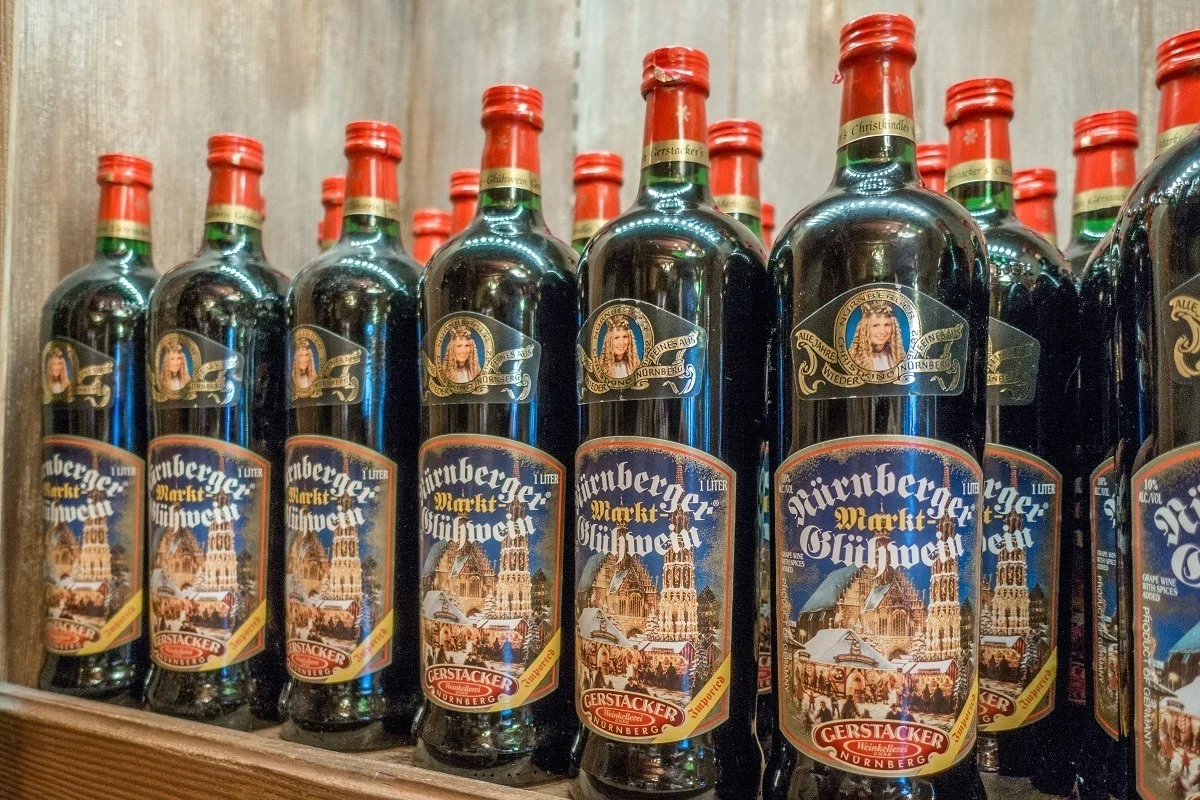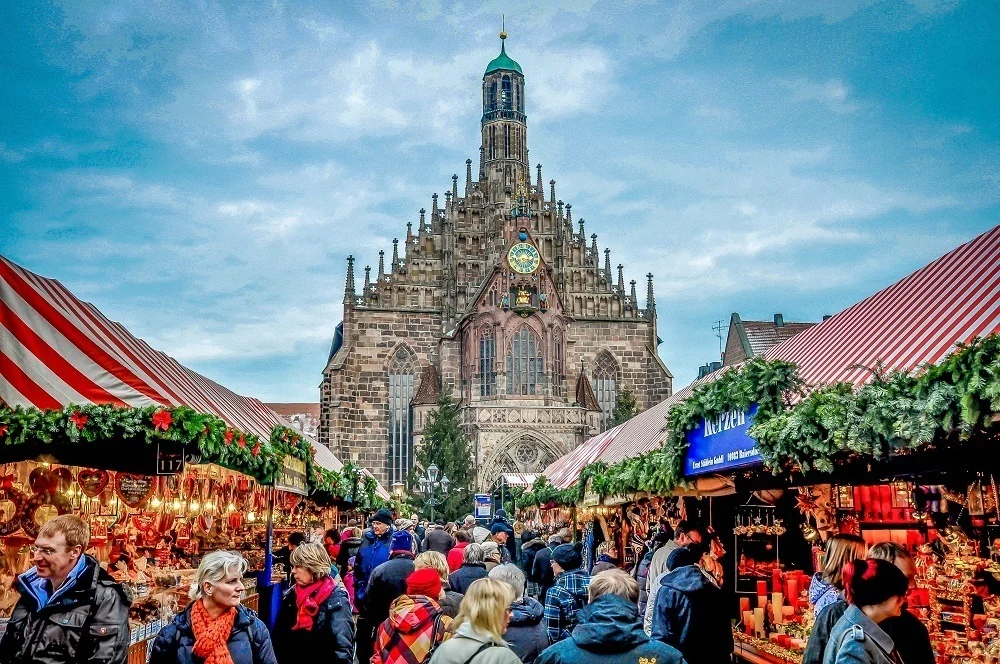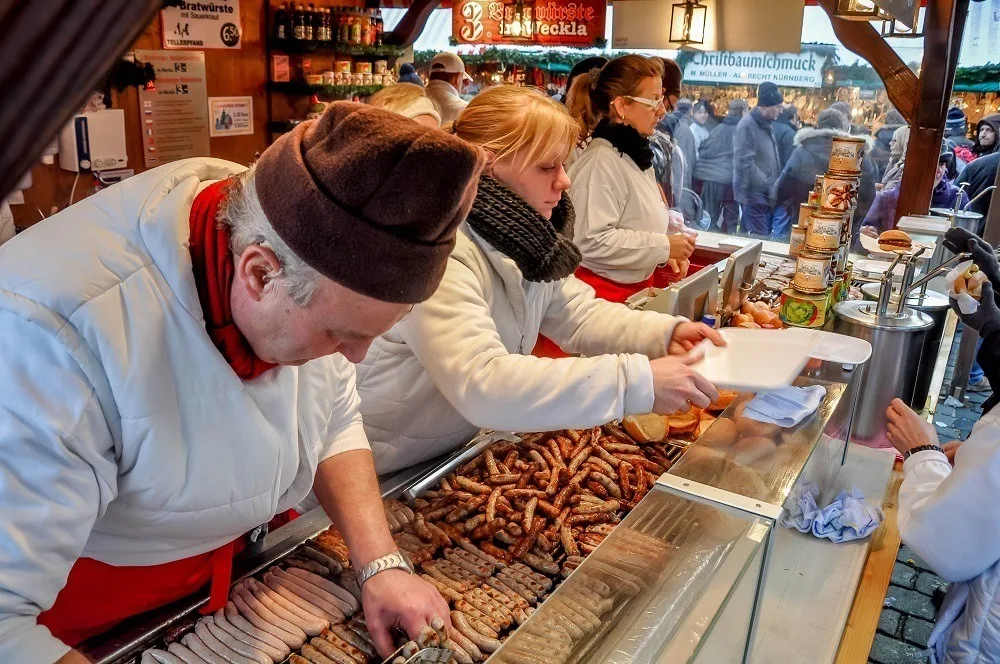The Nuremberg Christmas market in Germany is the king of all Christmas markets. Famous worldwide, the fairytale market is located in the heart of historic Nuremberg in the shadow of some of the city’s prettiest medieval buildings. While it is compact and easy to navigate, it is packed with over 200 vendors selling gifts, decorations, and the tastiest sausage this side of the Rhine. It is an absolute must-visit.
About the Nuremberg Christmas Market
The Christmas markets, or Christkindlesmarkt in German, are a quintessential Christmas experience. And none is better than Nuremberg. Over 2 million tourists descend on this city of only 500,000 every December to take part. If it sounds like tourist overload, it isn’t.
Being American, we are used to the commercialism that often accompanies the holidays. But the visit to the Nuremberg Christmas market was a charming and romantic experience–where tourists and locals commune together in the cold and embrace the season. To put it simply, it is absolutely enchanting.
What is the Christmas Angel?
Nuremberg has a unique tradition–the Christmas Angel, or Christkind. She’s a symbol of the market and of Christmas itself, with children waiting with bated breath to see her just as children in the US get excited about Santa.
The idea that the Christkind brings gifts to the children of the city goes back to Martin Luther and the Protestant Reformation. Luther wanted to move away from venerating Catholic saints and saint’s days, which meant a change from the traditional gift giving on December 6th, St. Nicolas’s Day. Instead, he told his children that “Holy Christ” brought their presents.

Over time, this gift-giver took on the human form of a Christmas angel with a feminine appearance. That is why a teenage girl is chosen as the Christkind.
The Christkind presides over the opening of the festivities each year and makes regular appearances around the city. She’s often at the Children’s Market, and Lance even got to take a stagecoach ride with her around old town.
Where are the markets?
The Christkindlesmarkt has three different markets in one, and each has a slightly different focus.
Christkindlesmarkt
The largest market is in the Hauptmarkt, the city’s main square, and is the highlight of visiting Nuremberg at Christmas. Long rows of vendors stretch the length of the medieval square leading right to the front door of the Frauenkirche, the city’s iconic 14th-century church.
In this market, vendors sell all the decorations you could ever want. There are lights, lanterns, and nativity sets in all sizes. You’ll also find beautiful model Christmas villages and tons of ornaments.
In addition to the typical items, there are also a lot of characteristic German decorations. You’ll find Christmas pyramids, schwibbogens (traditional candle arches), and nutcracker figurines in every persona and price point ranging from small, mass-produced soldiers to large, handmade Santas designed to become family heirlooms. Smokers–figurines that “exhale” smoke when the incense inside them is burned–are very popular, too.
Unique to Nuremberg are the zwetschgenmannle, or prune people. There are more than 350 different fruit-and-nut prune man figures ranging from musicians to chimney sweeps to hikers. You’ll even find ministers and the devil among the assortment.
Sister Cities Market
Located just north of the Christkindlesmarkt is the “Sister Cities” market. These vendors sells traditional items related to the cities around the world that are sister cities of Nuremberg. Participating cities include Antalya (Turkey), Atlanta (USA), Kharkiv (Ukraine), Glasgow (Scotland), Kavala (Greece), Krakow (Poland), Nice (France), Prague (Czech Republic), San Carlos (Nicaragua), Shenzhen (China) and Skopje (North Macedonia).
If you’re looking for unique items but want something different from the typical offerings, the Sister Cities market is for you. With more than 20 booths selling products from around the world, it’s a one-stop shop for everything from Scottish wool to Nicaraguan coffee to Chinese jewelry. Some of the stalls are operated by non-profits with proceeds going to charities in the sister cities, so you can feel good about your purchases, too.
In addition to local crafts and gifts, the stalls offer food and drinks representative of the cities. There is whiskey cake (and plenty of actual whiskey) from Scotland, apple cider drinks from Atlanta, and many kinds of gluhwein that have been given a local twist.
Children’s Market

The third market is the Children’s Market (Kinderweihnacht). Just a 3-minute walk from the Hauptmarkt, it is designed for Nuremberg’s smallest visitors.
There is a carousel, a mini Ferris wheel, and a steam train to keep everyone busy. Even the stalls are modified to make it easier for children to reach the items. At the hands-on booths, kids can experience the joy of Christmas through various crafts and experiences like baking and decorating honey cakes, making candles, and decorating personalized Christmas cards. Even if you’re not traveling with children, it’s nice to visit this area where the fun is infectious.
When are the markets?
The festivities typically begin on the Friday before the first Sunday in Advent and they continue through Christmas Eve. The markets are open every day from 10am to 9pm, except for Christmas Eve when they close at 2pm.
This year’s markets are scheduled for December 1- December 24, 2023.
What to eat
There is food and drink everywhere, which makes for a great way to warm up when you’re freezing because Nuremberg in December can be quite cold. Here are some of the traditional specialties.
Nurembergers
Rostbratwurst, aka Nurembergers, are small marjoram-flavored pork sausages that have been staples in the city for at least 500 years. In the market, you’ll most often seen them sold as Drei im Weckla (three in a bun), which is just enough to keep you going on a cold day. Try them with a bit of senf, or German mustard, but be careful because a little goes a long way.
Lebkuchen
Gingerbread (lebkuchen) is very popular at the holidays in German markets from Trier to Cologne. You’ll see it in many stands heavily decorated with icing, but those aren’t the best kinds for eating–they’re more for decoration.
The kind you want to eat is a circular cookie. You’ll often see them topped with a few almond slivers, a sugar coating, or a few pieces of candied orange rind. Moist and full of honey and spices, lebkuchen is a delicious treat and is also one of the vegetarian options at the market.
Gluhwein

The most popular drink at the Christmas markets (in Germany and around Europe) is one of our favorites. Gluhwein is hot, mulled wine, infused with the flavors of the season like cinnamon and cloves.
There is a small deposit for the gluhwein mug, so you can have the warm drink as you browse the stands. When you’re finished, just return the mug to another vendor to get your deposit back or keep it as a souvenir. You can also find a non-alcoholic version called kinderpunsch.
Feuerzangenbowle
Similar to gluhwein, feuerzangenbowle is a drink that incorporates a bit of a show. A rum-soaked sugar cube is set on fire, and the melted sugar drips into the mulled wine below. Nuremberg is home to the largest feuerzangenbowle in the world–it holds 9000 liters and takes two days to heat up.
More things to do at Christmas
If you’re looking for other things to do or just want to get out of the cold, this beautiful city has lots to offer beyond the Christmas markets.
Visit Germany’s most famous Christmas store
Käthe Wohlfahrt is the place for decorations. If there’s something specific that you’re looking for but you can’t find it in the market, there’s a good chance they’ll have it here. Their Nuremberg location is open year-round and their ornaments, decorations, and smokers are top quality.
Take a stagecoach tour

There’s no better way to see the city than on a stagecoach tour. The 15-minute tour costs just a few euros and gives you a tour of the old town. Driving through the streets with the horseshoes clomping on the cobblestones, everyone you pass will stop to wave. It’s almost like being a minor celebrity.
Visit the Imperial Castle

The Imperial Castle is one of the top tourist attractions, regardless of the season. A symbol of the city for over 1000 years, it was a favorite stopping place for Emperors of the Holy Roman Empire and was a key location for court assemblies and meetings of the most important people in the realm.
Reconstructed following damage suffered during World War II, the castle is one of the sightseeing highlights. You can see its original tower, visit the well that provided water to the citizens of the city hundreds of years ago, and marvel at the ancient weapons and artwork in the castle museum.
Step inside Albrecht Durer’s House

Painter, engraver, and printmaker Albrecht Durer is Germany’s most famous artist. For nearly 20 years—beginning in 1509 until his death—he lived and worked in the large half-timbered house near the castle that has since been preserved and turned into a museum.
The museum features valuable copies of Durer’s most famous works and furnishings of the kind he would have owned along with a recreation of his workshop. Visitors can watch copper plate engravings on site for a glimpse into Durer’s techniques and can take a tour with an actress playing Agnes Durer, the wife of the artist.
See the churches

There are several noteworthy churches worth visiting. At Christmas, many of them have nativity scenes and are decorated for the season. Plus, they’re great places to get out of the cold weather.
In the Hauptmarkt square, the Frauenkirche was built in 1352 by Charles VI, Holy Roman Emperor. It contains numerous works of art and sculptures from the Middle Ages and is famous for its clock whose figures perform every day at noon.
In addition, there is St. Lorenz Church that dates from 1250. With its two 260-foot-tall towers and rose window, it is worth a visit as you stroll down Konigstrasse. St. Sebald Church, the oldest church in Nuremberg, has frescoes from the Middle Ages as well as a number of Renaissance statues and carvings.
Where to Stay
Le Meridien Grand Hotel — Right at the entrance to old town, the location of the Le Meridien can’t be beat. We loved the comfortable bed, the fabulous breakfast buffet, and the bubbly happy hour. Plus, the staff is extremely helpful and loves making recommendations for the best local spots.
NH Collection Nurnberg City — This four-star hotel is a great spot from which to explore the city. The breakfast buffet is extensive, and the hotel offers an on-site restaurant and a gym with a steam room and sauna.
Lance Longwell is a travel writer and photographer who has published Travel Addicts since 2008, making it one of the oldest travel blogs. He is a life-long traveler, having visited all 50 of the United States by the time he graduated high school. Lance has continued his adventures by visiting 70 countries on 5 continents – all in search of the world’s perfect sausage. He’s a passionate foodie and enjoys hot springs and cultural oddities. When he’s not traveling (or writing about travel), you’ll find him photographing his hometown of Philadelphia.








Diane
Tuesday 19th of September 2023
We are arriving Munich November 28,2023 ; was planning to travel to Numenberg that day but discovered that the market does not open until December 1st. Is it worth the train ride from Munich to just see the decorations and not be able to shop at any of the markets?
Lance Longwell
Wednesday 20th of September 2023
The beauty is the market. Nuremberg, like most cities in Europe, doesn't "decorate" much beyond the markets. An alternative: Regensburg's market opens earlier.
annemarie schweitzer
Saturday 4th of December 2021
Great to see all the pictures- reminds me of a visit ,we went to a kellerwirtshaft and had the best gulashsoup ever,have tryd to find the recpe- without success. it was served in a bowl, with a small hard roll- anyone knows how to make this? thank you!
Craig
Tuesday 19th of January 2016
I _love_ Nuremberg :) We so enjoyed it there in the summer, but have never been at market time.
Sherri
Sunday 17th of January 2016
Thanks for the information! We just booked a New Year's river cruise from Basel to Amsterdam. We will fly into Basel 14-16 days early to do some traveling to Christmas markets and sightseeing. What markets would you recommend? Thinking of traveling to Frankfurt, Nuremberg, and Salzburg for the markets, then traveling through Switzerland (Glacier Express) and then Lake Geneva, Bern and Lucerne. Have flexibility and would love to hear of must stops/must sees in those regions.
Lance Longwell
Wednesday 20th of January 2016
It's highly subjective, but our must recommend markets are: Nuremberg, Salzburg, Erfurt and Munich. We'd skip Frankfurt.
Wandering Educators
Tuesday 15th of April 2014
Oh, those sausages!! and the nutcrackers! we need to go!
Laura Longwell
Wednesday 16th of April 2014
The markets are really amazing! Hope to get to more soon some time in the next couple of years!